This table lists known plaques, selected artefacts, and memorials to Charles Joseph La Trobe.
| Site/Item | Location | Image | Description | |
| Melbourne | click picture to enlarge | |||
| AgnesHouse | 49 Agnes Street, East MelbourneStreet ViewView Map |
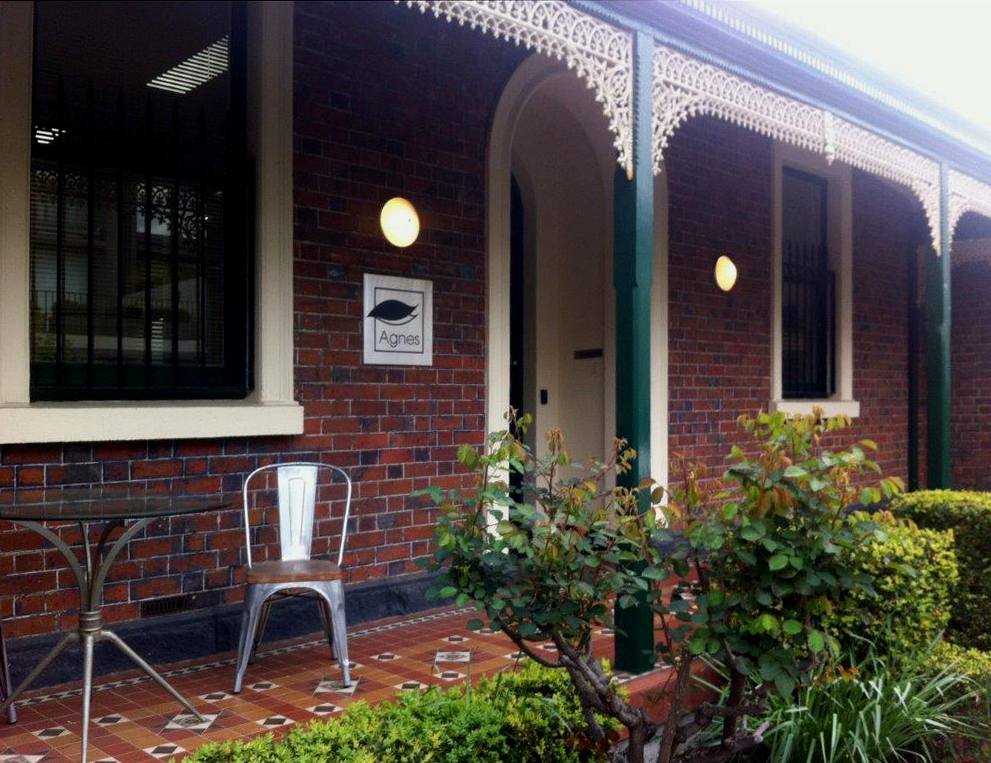 |
Building (formerly ‘Bourgoyne Cottage’, 1866) renamed after La Trobe’s eldest daughter Agnes, who lived with her family at ‘Jolimont’ from 1839 to 1845, when she was aged two to eight. This area of East Melbourne was formerly known as Jolimont. | |
| Flagstaff Gardens | La Trobe and King Streets, MelbourneStreet ViewView Map | 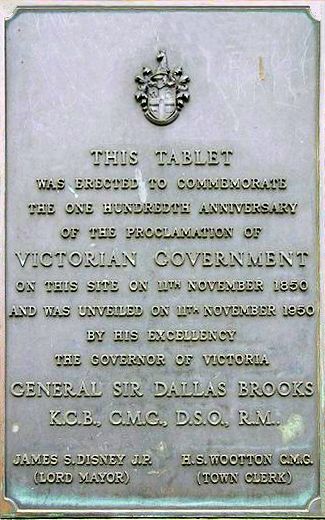 |
Plaque unveiled 11 November 1950 to commemorate the centenary of the proclamation (12 November 1850) of Port Phillip District’s separation from New South Wales and self-government for Victoria (from 1 July 1851). | |
| JolimontPlaque | 22 Agnes Street, East MelbourneStreet View View Map |
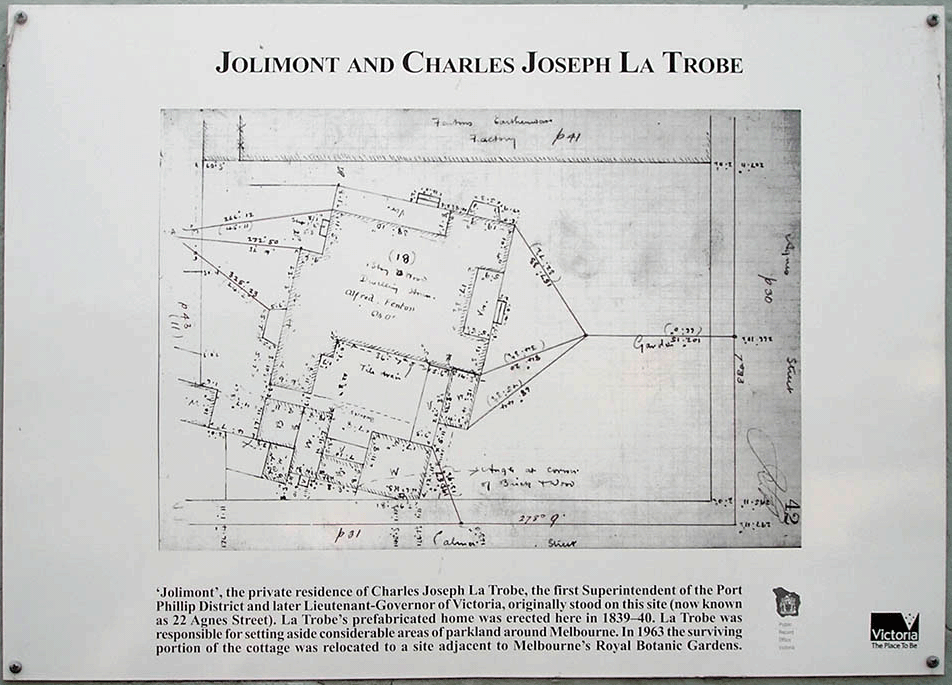 |
Plaque installed by the Public Record Office near the original site of La Trobe’s Cottage on his ‘Jolimont’ estate. Agnes Street is named after La Trobe’s eldest daughter. This area of East Melbourne was formerly known as Jolimont. |
|
| La Trobe’s CottageBuildingPlaqueCommemorative stone | Birdwood Avenue & Dallas Brooks Drive, MelbourneVirtual TourView Map | 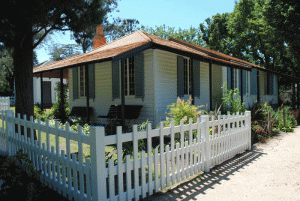 |
La Trobe’s original dining room and largely reconstructed portable cottage and servants’ block. Originally located on his ‘Jolimont’ estate. The cottage contains furniture and artefacts that belonged to the family. | |
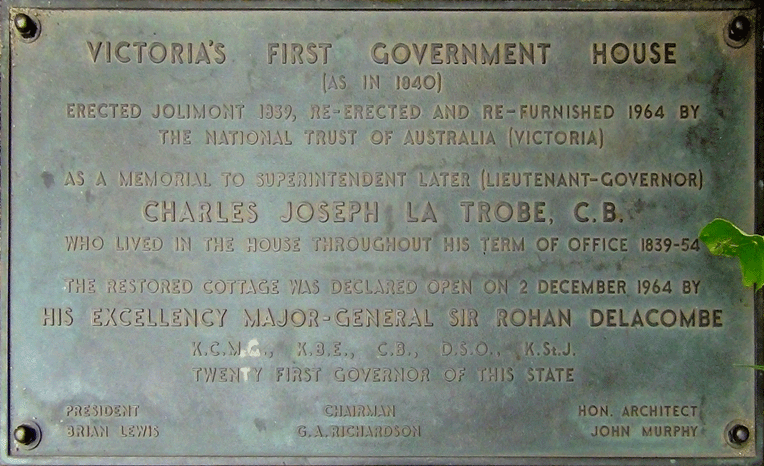 |
Plaque located in the garden at the front of the Cottage that was relocated in December 1964, and again in October 1998. | |||
| Unveiled by a member of the Baltic branch of the La Trobe family, Dr John Henry de La Trobe of Hamburg, and commemorates the 150th anniversary of La Trobe’s arrival in Melbourne. The tree was replanted in 2011. | ||||
| La Trobe UniversityStatueBuilding | Science Drive, Bundoora View Map |
> |
‘Landmark’ by Charles Robb, 2004. Fibreglass, polyester resin, polystyrene et al, 4.9m in height. Located near the West Lecture Theatres. | |
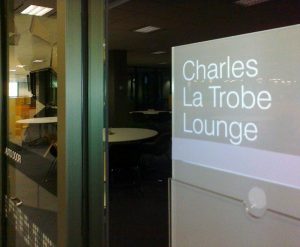 |
Charles La Trobe Lounge, a private meeting and study space for academic staff, emeritus professors, alumni and postgraduate research students at La Trobe University. In the Borchardt Library, Level 2. | |||
| Former Law Institute of Victoria (now Australian Technical & Management College Pty Ltd) | 470 Bourke Street, MelbourneStreet View | 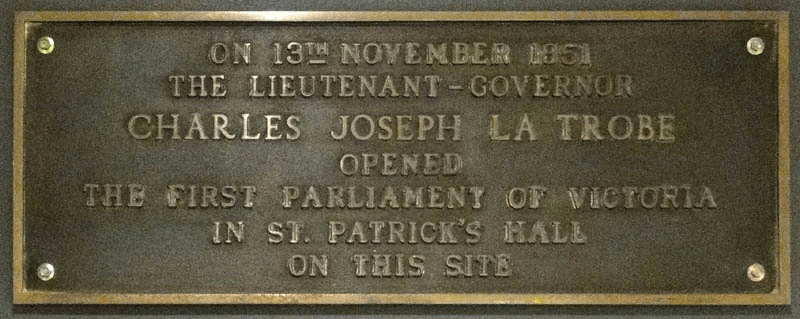 |
Commemorates the opening of the first Parliament (Legislative Council) by La Trobe in St Patrick’s Hall on this site on 13 November 1851. (In former Lecture Theatre, Mezzanine Floor – not accessible.) |
|
| Melbourne Town HallPaintingPlaquePlaquePlaque | Swanston & Collins Streets, MelbourneStreet ViewView Map | 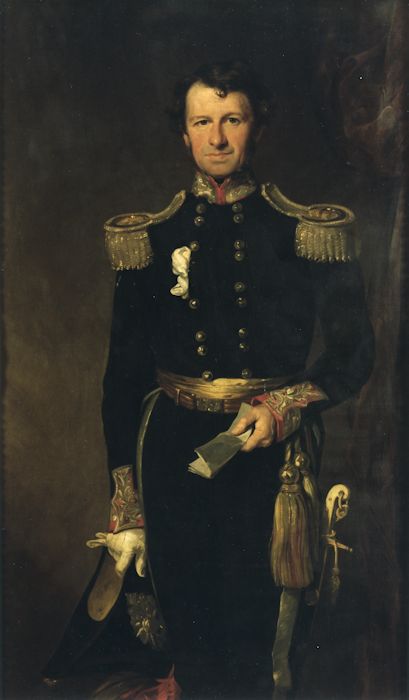 |
‘Charles Joseph La Trobe’ by Sir Francis Grant, 1855. Oil on canvas. Official portrait of La Trobe (in his lieutenant-governor’s uniform) subscribed for by the colonists of Victoria. Following a fire in 1925 it was cut down from the original full-length portrait. Located in the Lord Mayor’s Room. | |
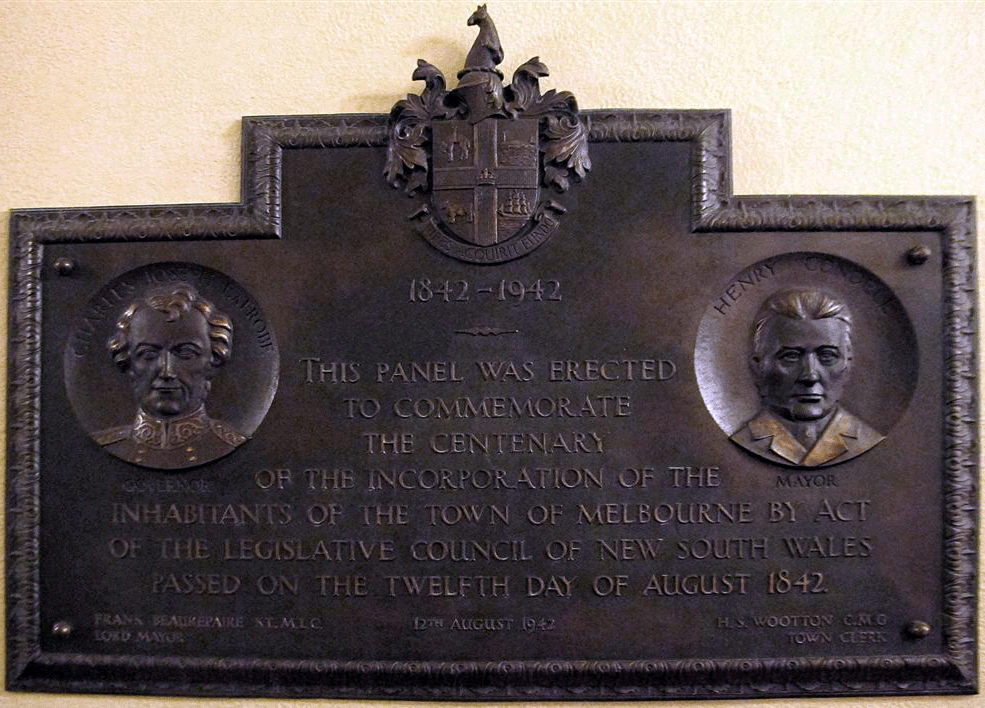 |
Bronze plaque outside the Lord Mayor’s Room with reliefs of La Trobe and the first mayor, Henry Condell, commemorating the centenary of the town’s incorporation on 12 August 1842. | |||
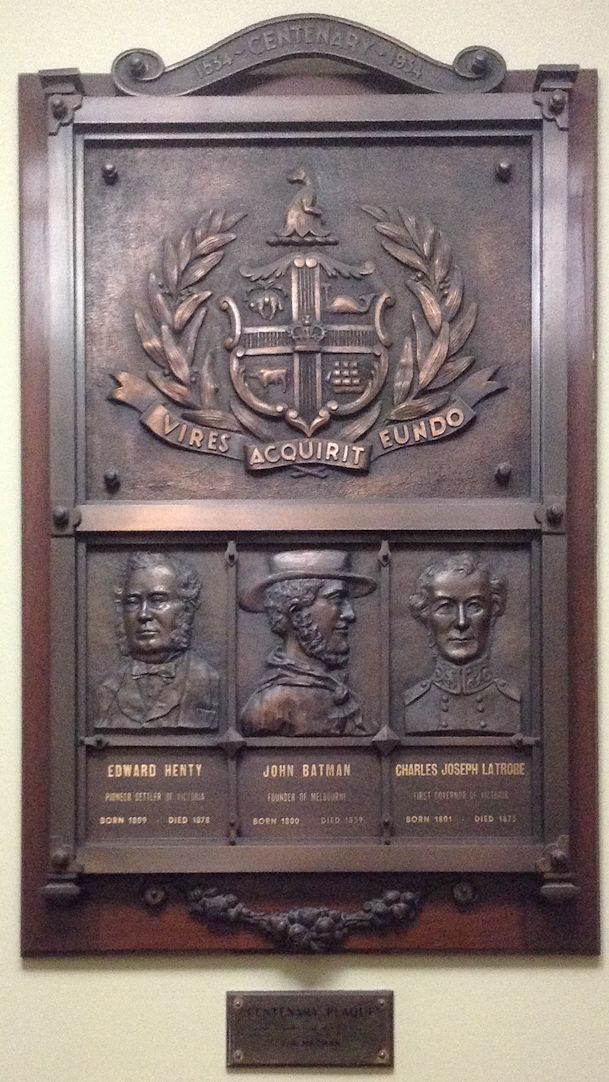 |
Bronze plaque inside the Administration entrance with reliefs of La Trobe, Edward Henty and John Batman, commemorating the centenary of the foundation of Victoria and Melbourne in 1834/35. | |||
 |
Commemorates the laying of the foundation stone of the second bridge over the Yarra River on 20 March 1846. The single-span sandstone bridge was opened by La Trobe on 15 November 1850. The plaque is in the ongoing exhibition of the City of Melbourne Art and Heritage Collection on the Fourth Floor of the Town Hall. |
|||
 |
‘Larry La Trobe’, a bronze sculpture of a dingo-type dog by Pamela Irving (1992) – recast in 1996 after the theft of the original. Larry, one of Melbourne’s most loved sculptures, sits on the Swanston Street footpath close to the corner with Little Collins Street. He was named after the artist’s uncle Larry and La Trobe Street, Melbourne. | |||
| National Gallery of VictoriaCandelabrum | Federation Square, MelbourneStreet ViewView Map | 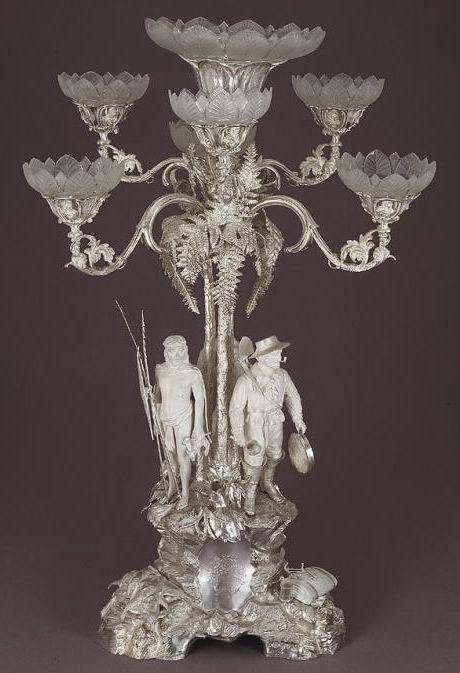 |
Testimonial candelabrum centrepiece presented to La Trobe after his return to England in 1854. (Silversmiths: Stephen Smith & William Nicholson, London, 1854-55. 81cm high.) | |
| Old Treasury BuildingPainting | Spring Street, MelbourneStreet ViewView Map |  |
‘Charles Joseph La Trobe’ by Sir Francis Grant, 1855. Oil on canvas, c. 217 x 103 cm. Portrait of La Trobe in his lieutenant-governor uniform. A version of the official portrait at the Melbourne Town Hall. Presented to the National Trust of Australia (Victoria) by Captain Charles La Trobe. (Located in the Executive Council chamber.) | |
| Parliament HousePlaque | Spring Street, MelbourneStreet ViewView Map | 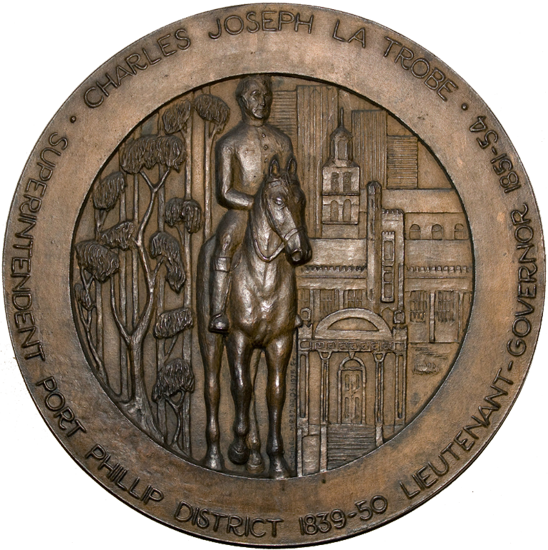 |
Commemorative plaque of the centenary of La Trobe’s death unveiled 4 December 1975. The first Parliament (Legislative Council) was opened by La Trobe in St Patrick’s Hall, since demolished, in Bourke Street on 13 November 1851. | |
| Royal Botanic GardensBuilding with inscriptionPlaqueTree | Birdwood & Alexandra Avenues, MelbourneStreet ViewView Map | 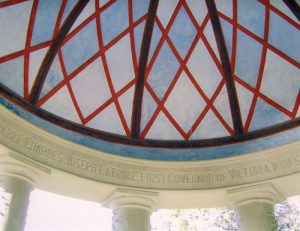 |
Temple of the Four Winds memorial to La Trobe, designed and erected in 1901 by the Director, William Guilfoyle. La Trobe had set aside the land for the Botanic Gardens that were founded in 1846. (Near the Northern Gate, Alexandra Avenue) | |
 |
Separation Tree plaque unveiled 15 November 1951 to mark the beginning of the second century of Victorian self-government on 1 July 1851. The tree, around which citizens celebrated on 15 November 1850, was vandalised in 2010 and 2013. (Near Bridge Gate, corner Alexandra Avenue & Anderson Street) Earlier plaque |
|||
 |
Elm Tree, planted in 2018 as a clone of the one La Trobe planted in 1851 prior to Separation from New South Wales. That one died in 1977, as did two other clones planted over the years. (Near the Eastern Gate, Anderson Street) 1851 elm |
|||
| Royal Melbourne HospitalBuilding with plaque | Grattan Street & Royal Parade, ParkvilleStreet ViewView Map |  |
Charles La Trobe Lecture Theatre. La Trobe was the first patron of the hospital that opened on the corner of Lonsdale and Swanston Streets on 15 March 1848. He had worked since 1841 to obtain funds for the hospital. A copy of his portrait (by Sir Francis Grant, 1855) hangs in the vestibule. Framed memorabilia, including correspondence with Governor Gipps, is displayed in the theatre itself. | |
| St James’ Old CathedralPlaquePlaquePlaque | King & Batman Streets, MelbourneStreet ViewView Map | 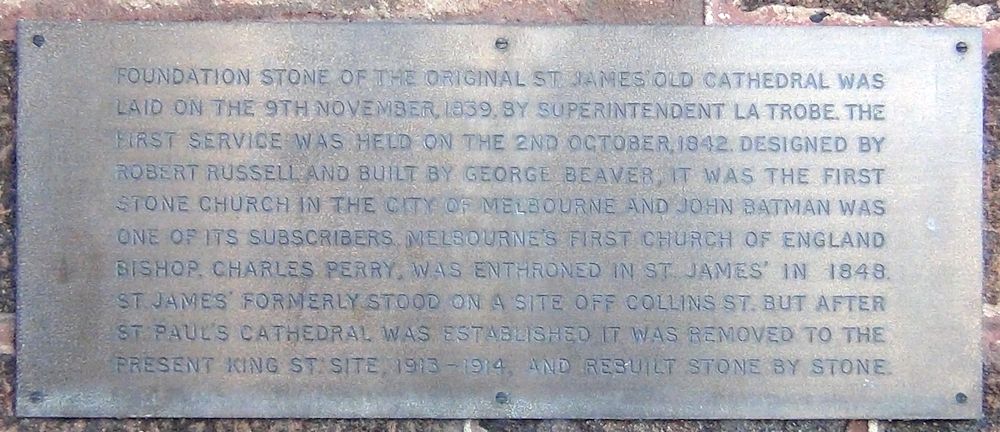 |
The foundation stone of St James’ Church was laid by La Trobe on 9 November 1839. At that time the church was located near the corner of William and Little Collins Streets. A commemorative service of the centenary of La Trobe’s death was held here on 14 December 1975. Plaque in situ.. |
|
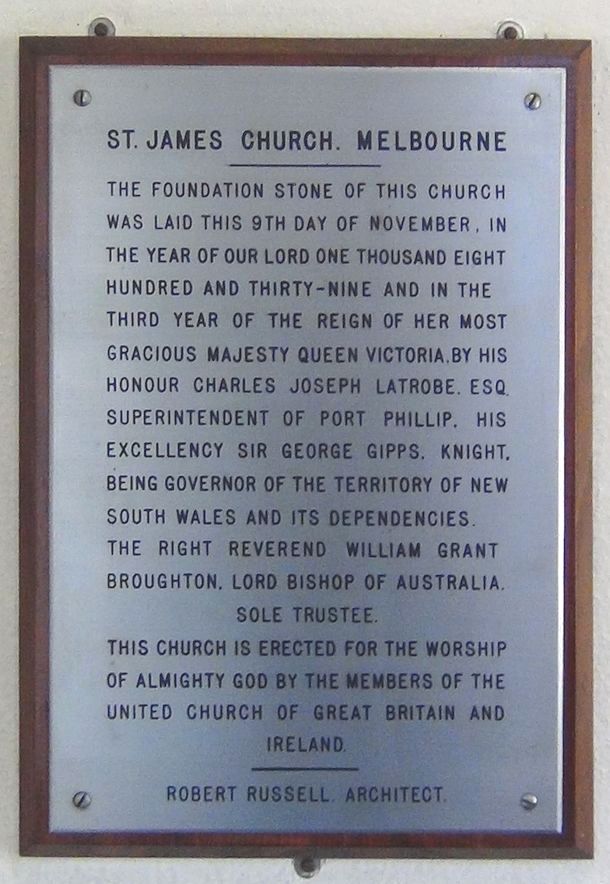 |
||||
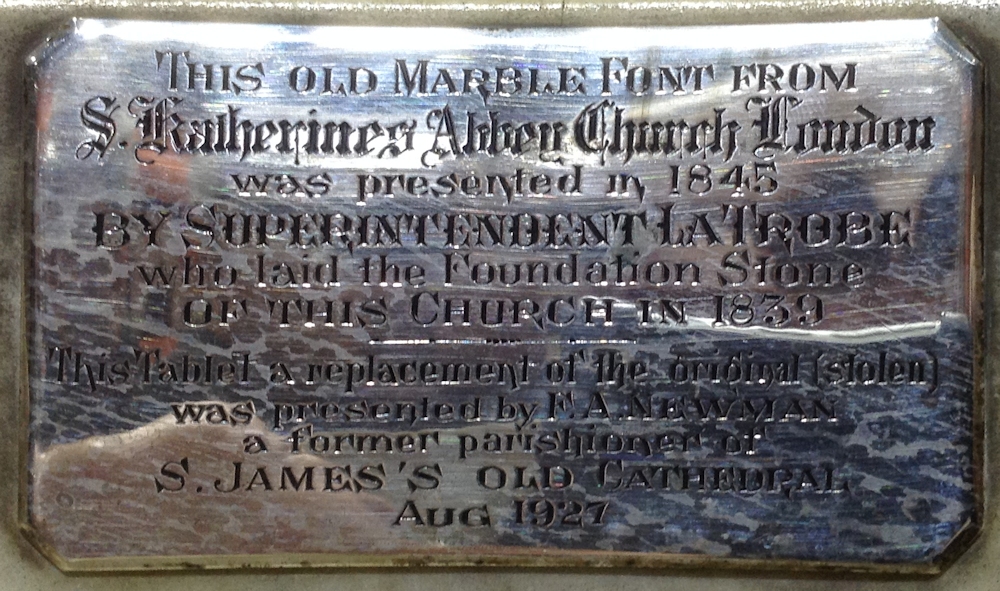 |
The baptismal font was presented by La Trobe in 1845; it was formerly at the demolished St Katharine’s by the Tower, London. Three La Trobe children were baptised in this church. | |||
| St Peter’s Eastern HillHonour boardTablet | 15 Gisborne Street, MelbourneStreet ViewView Map |  |
Commemorative service of the centenary of La Trobe’s death was held on 4 December 1975. The foundation stone was laid by La Trobe on 18 June 1846. The baptismal font was sent by him from England to his former parish church in 1854; he also presented a large oak coffer (trunk) to the church. The honour board contains a Thomas Woolner portrait medallion of La Trobe. | |
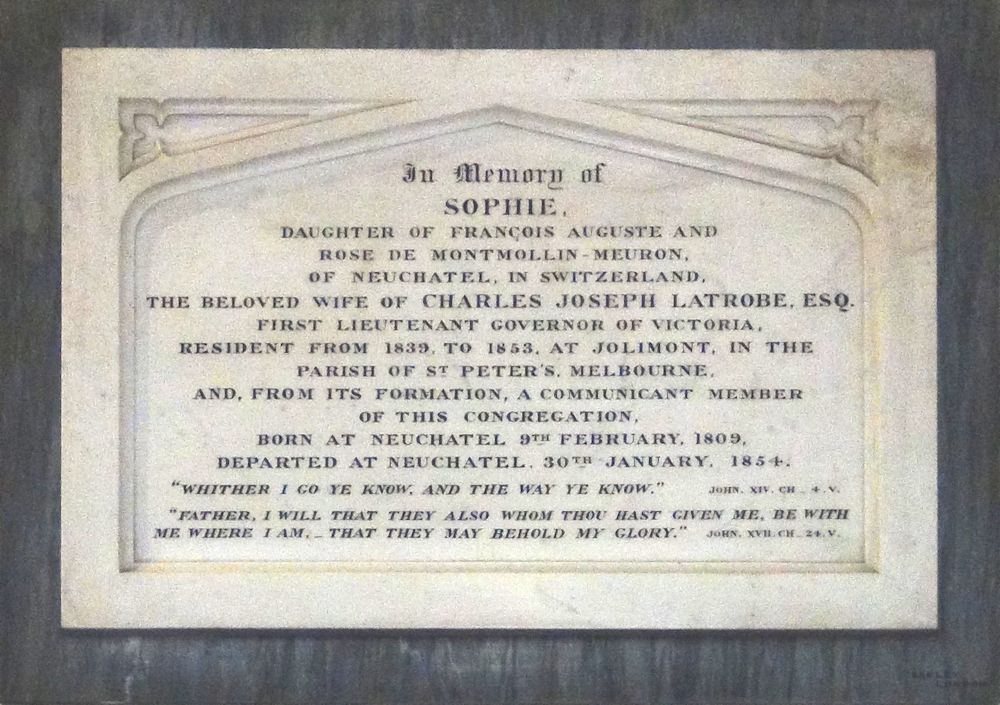 |
Marble tablet in memory of Sophie La Trobe, which La Trobe sent from England in 1855. He wrote at that time: ‘I think that she deserves to be remembered in the community of which she was so long a member’. (Sophie was born 8 February 1810; her father’s first name was Frederic.) | |||
| Christ Church, HawthornCommemorative stoneFont with plaquePulpit with plaque | Church & Denham Streets, HawthornStreet ViewView Map | 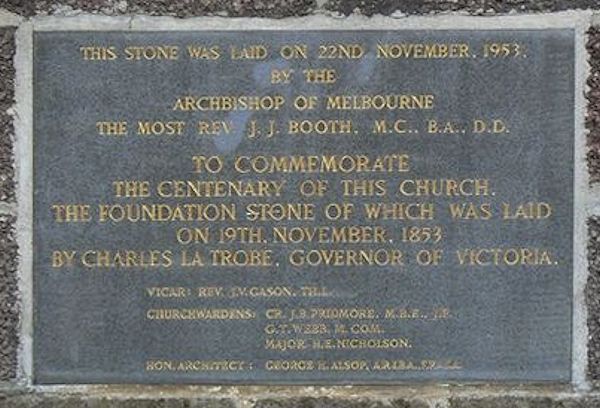 |
Commemorates the centenary of the laying of the original foundation stone by La Trobe on 19 November 1853. Trowel (located at Werribee Mansion) | |
 |
The baptismal font was presented by La Trobe in 1854, the year he left Victoria. It was formerly at the demolished St Katharine’s by the Tower, London. | |||
 |
Commemorates the 50 year jubilee of the laying of the foundation stone by La Trobe on 19 November 1853. Plaque | |||
| State Library VictoriaFoundation stoneBuildingPaintingStatue | Swanston & La Trobe Streets, MelbourneStreet ViewView Map | 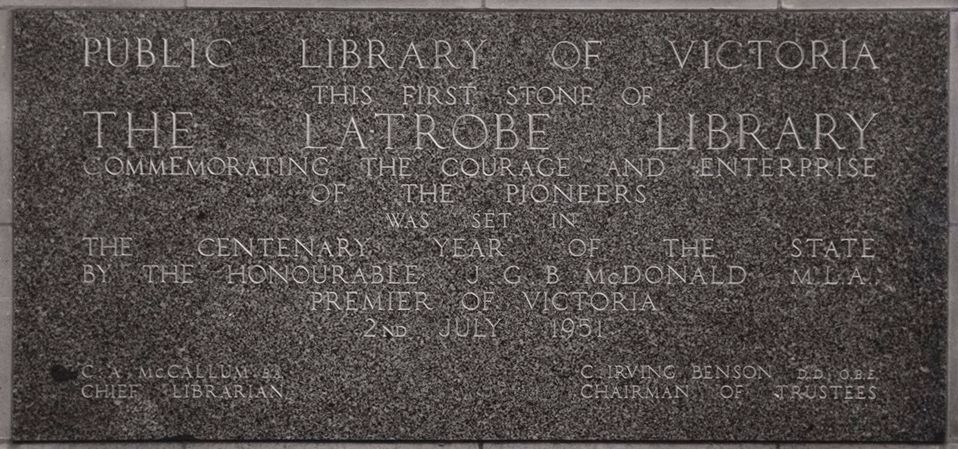 |
La Trobe Library foundation stone, laid 2 July 1951. Housing the extensive Australiana collections, the library (located on La Trobe Street) opened to the public on 29 March 1965; it was officially opened on 6 September 1965 and was closed 25 years later on 5 September 1990. More… | |
 |
La Trobe Reading Room, the name given in July 2003 to the restored Domed Reading Room that was first opened in 1913. It houses the general Australiana collection. | |||
 |
‘Charles Joseph La Trobe’ by Sir Francis Grant, 1855. Oil on canvas, 217 x 103 cm. Portrait of La Trobe in his lieutenant-governor uniform. A less finished version of the official portrait at the Melbourne Town Hall and painted for La Trobe himself. (Located at the entrance to the La Trobe Reading Room.) | |||
 |
‘C. J. La Trobe’ by Peter Corlett OAM, 2006. Bronze, 1.3 times lifesize, 2.5m in height on 50cm base. Commissioned by the C J La Trobe Society and unveiled during the Year of La Trobe. (Located on the forecourt of the Library.) Digital photographic art |
|||
| Tasma Terrace, National Trust of Australia (Victoria)Trowel | 4 Parliament Place, East MelbourneStreet ViewView Map |  |
Gold-plated trowel presented to La Trobe at the laying of the foundation stone of the Geelong Railway Terminus 20 September 1853. Plated over copper alloy. Goldsmith: I. Krauss, Geelong. (Not on display) | |
| Temple CourtMural | 422 Collins Street, MelbourneStreet ViewView Map |  |
‘The “Eight” Aboriginal Tribal Headmen’, by Napier Waller. 1963, mosaic mural, 392cm x 246 cm (approx.) Depicts eight heads of the Kulin nation, each holding a portrait of a European man regarded as significant in the early European settlement of the Port Phillip District: La Trobe is in a framed oval portrait. (Entrance foyer, west; not accessible) |
|
| Williamstown Lighthouse and Timeball TowerPlaque | Point Gellibrand, WilliamstownStreet ViewView Map |  |
Commemorative plaque of the centenary of La Trobe’s death unveiled 14 December 1975. The lighthouse was erected in 1849 and replaced a timber tower built in 1839/40 soon after La Trobe arrived in Melbourne. The timeball was added in 1852. | |
| Australian Railway Historical Society MuseumPlaque | Champion Road, Williamstown NorthStreet ViewView Map |
 |
Brass name and number from the locomotive S 303 C J La Trobe that was in service for 23½ years for the Spirit of Progress passenger train from Melbourne to Albury, until it was scrapped in 1954. | |
| Werribee MansionTrowel | K Road, Gate 2, Werribee Park, WerribeeStreet ViewView Map |
 |
Silver trowel, with ivory handle, presented to La Trobe at the laying of the foundation stone at Christ Church, Hawthorn on 19 November 1853. Silversmith: John Henry Bates, Melbourne. (The trowel is on long-term loan from The Vizard Foundation.) | |
| Anchor | ||||
| Site/Item | Location | Image | Description | |
| Geelong & District | click picture to enlarge | back to top | ||
| Geelong Botanic GardensPlaque | Eastern Park, Geelong East Street View View Map |
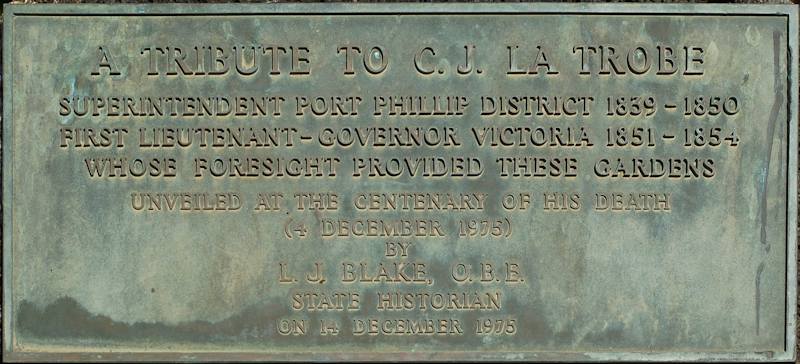 |
Commemorative plaque of the centenary of La Trobe’s death unveiled 14 December 1975. La Trobe set aside the land for the Botanic Gardens that were founded in 1851. | |
| Geelong Government OfficesMural | Little Malop & Fenwick Streets, Geelong Street View View Map |
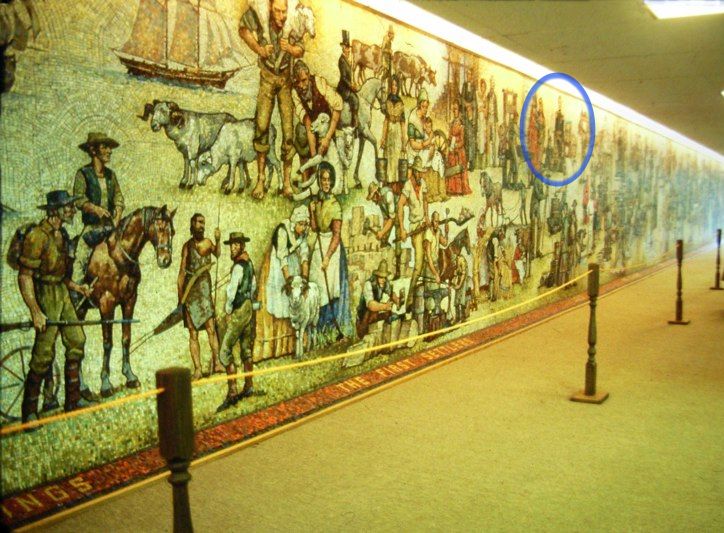 |
‘Regional History of Geelong’, by Harold Freedman, 1978-1980, glass mosaic mural. Dimensions 30m. x 2.5m. Depicts La Trobe in the upper part of the mural, at the intersection of ‘The First Settlers’ and ’Gold’. Freedman was State Artist 1972-1983 Detail | |
| Johnstone ParkPlaque | Gheringhap & Mercer Streets, Geelong Street View View Map |
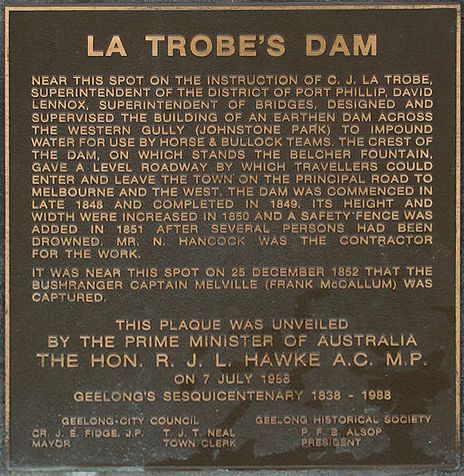 |
Commemorates La Trobe’s Dam that was built on the highest point of 55 acres (22.5 ha.) that La Trobe set aside for public use in 1848. The park was created in the late 1860s and is now 2½ hectares in area. | |
| Limeburners PointPlaque | Geelong East Street View View Map |
 |
Keys found at this site in 1847 were shown to La Trobe who believed them then to be probably 50 years old. La Trobe was a keen amateur geologist and at the time was examining an excavation for the lime works near the shoreline. | |
| St Paul’s Anglican ChurchPlaque | Latrobe Terrace & Brougham Street, Geelong Street View View Map |
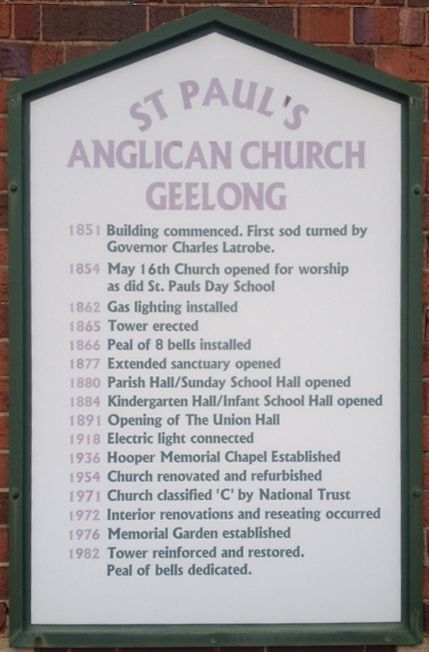 |
Charles Joseph La Trobe turned the first sod in December 1850. The church was built from 1851-1854 from designs of noted architect Charles Laing. | |
| St George the MartyrPlaque | Mercer & Hobson Streets, Queenscliff Street View View Map |
 |
Commemorative plaque of the centenary of La Trobe’s death unveiled 7 December 1975. The church was built on, or near to, the site of La Trobe’s former holiday house, one of the earliest dwellings at Shortland’s Bluff (which La Trobe named Queenscliff in June 1853). | |
| Queenscliffe Historical MuseumStatue | 49 Hesse Street Queenscliff Street View View Map |
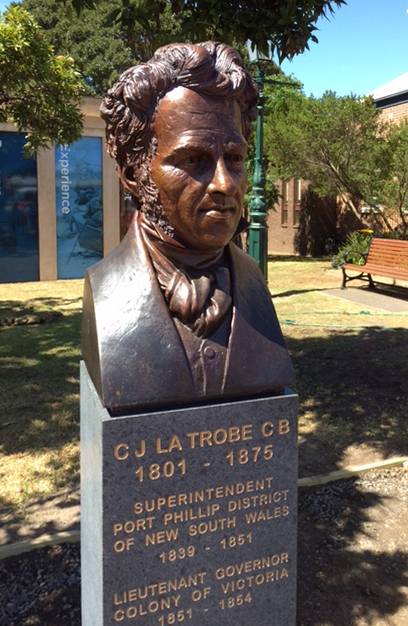 |
‘C. J. La Trobe CB’ by Peter Corlett OAM, 2016. Bronze bust on granite plinth. Commissioned by the Queenscliffe Historical Museum to commemorate La Trobe’s contribution as the Founding Father of Queenscliff. (Located on the forecourt of the Museum.) | |
| Cape Otway Lighthouse Plaque | Lighthouse Road, Cape Otway Street View View Map |
 |
Commemorative plaque of the centenary of La Trobe’s death unveiled 13 December 1975. La Trobe personally blazed a track through the dense Otways to finally reach the treacherous Cape on which to erect a necessary lighthouse in 1848. | |
| Site/Item | Location | Image | Description | |
| Other Victoria | click picture to enlarge | back to top | ||
| La TrobeBuilding | 2683 Point Nepean Road (corner Tyrone Avenue), Rye Street View View Map |
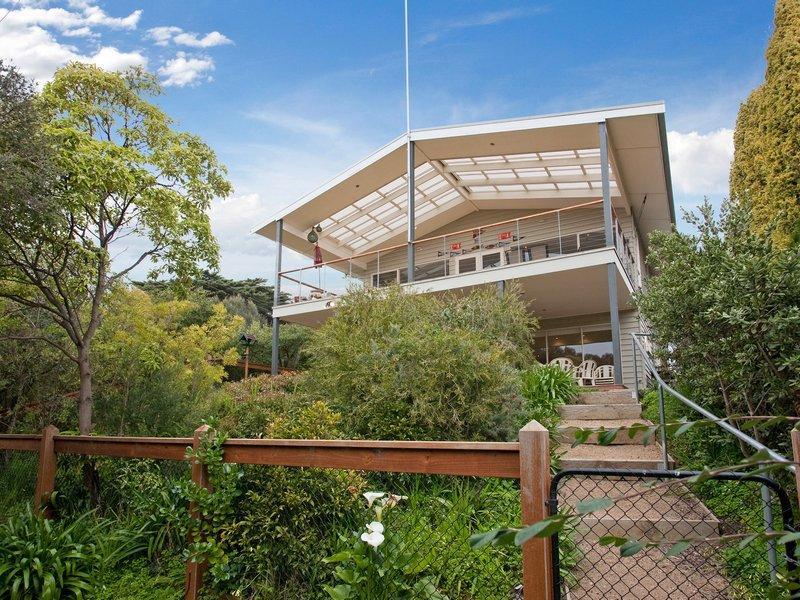 |
Two-story timber holiday house built in the 1960s by a Melbourne family who had an interest in and connection with the La Trobe era. The property overlooks the entrance to Port Phillip and across to Queenscliff, a location very significant in La Trobe’s life. (Signage of original owners now removed.) |
|
| La Trobe ReservePlaque | Latrobe Parade & Point Nepean Road, Dromana Street View View Map |
 |
Commemorative plaque of the centenary of La Trobe’s death unveiled 6 December 1975. La Trobe made many journeys to the Mornington Peninsula and to the McCrae Homestead at Arthur’s Seat. Cairn with plaque. |
|
| Seymour Railway Heritage CentreLocomotive | Oak Street, Seymour Street View View Map |
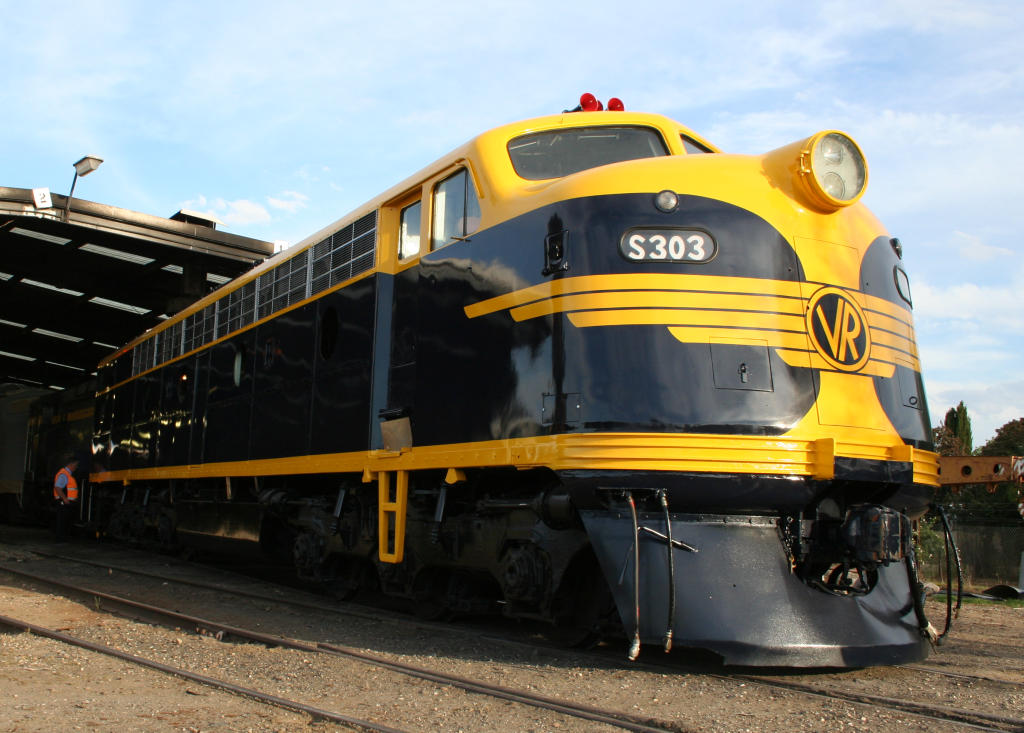 |
‘S-303 C J La Trobe’ diesel locomotive built in 1957 by Clyde Engineering, Granville, NSW, and bearing the same moniker and name as its steam predecessor of 1930. In service for the Spirit of Progress passenger train from Melbourne to Albury until 1988. |
|
| Yan Yean ReservoirPlaque | Recreation Road, Yan Yean Street View View Map |
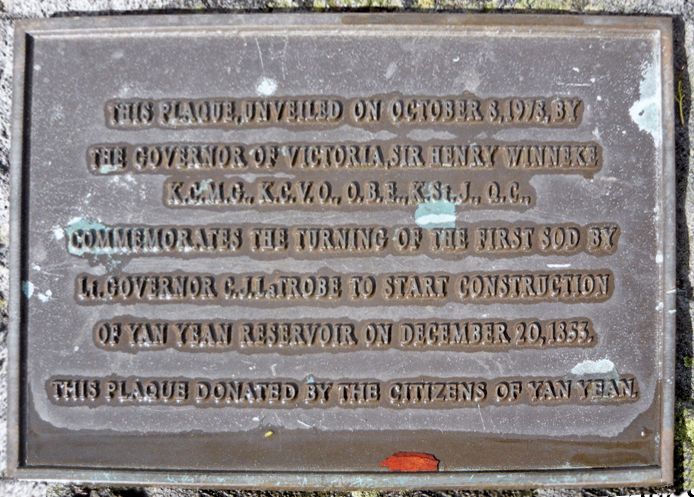 |
Commemorates the turning of the first sod for Melbourne’s first water supply system by La Trobe, 20 December 1853, on the Plenty River. The reservoir opened on New Year’s Eve 1857 (but was taken offline in February 2007). Cairn with plaque. |
|
| Site/Item | Location | Image | Description | |
| Interstate | click picture to enlarge | back to top | ||
| Queensland Art GalleryVase | Stanley Place, South Brisbane Street View View Map |
 |
Victorian sterling silver presentation vase, believed to have been presented to La Trobe when he was awarded an overdue pension in 1865 for his colonial service in Port Phillip/Victoria. The inscription has been removed. (Silversmiths: Hunt & Roskell,1864. Height 53 cm, weight 10.1kg.) | |
| Site/Item | Location | Image | Description | |
| Europe | click picture to enlarge | back to top | ||
| Natural History MuseumGold nugget | Cromwell Road, London, England Street View View Map |
 |
The Latrobe Nugget was acquired by La Trobe in 1853 when it was discovered in a McIvor (Heathcote) mine. He sold it to the Natural History Museum in 1858. It is one of the largest and finest groups of cubic gold crystals in the world. | |
| St Michael the ArchangelHeadstone | Litlington, East Sussex, England Street View View Map |
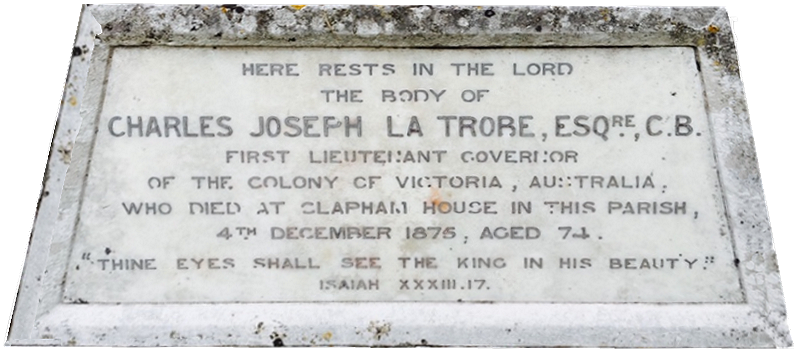 |
La Trobe died at Clapham House, the manor house in the village of Litlington, on 4 December 1875. The parish church, dating to the 12th century, is in the Diocese of Chichester. Headstone, Inscription |
|
| Chapelle de l’ErmitageMemorial chapelMemorial window | Neuchâtel, SwitzerlandStreet View View Map |
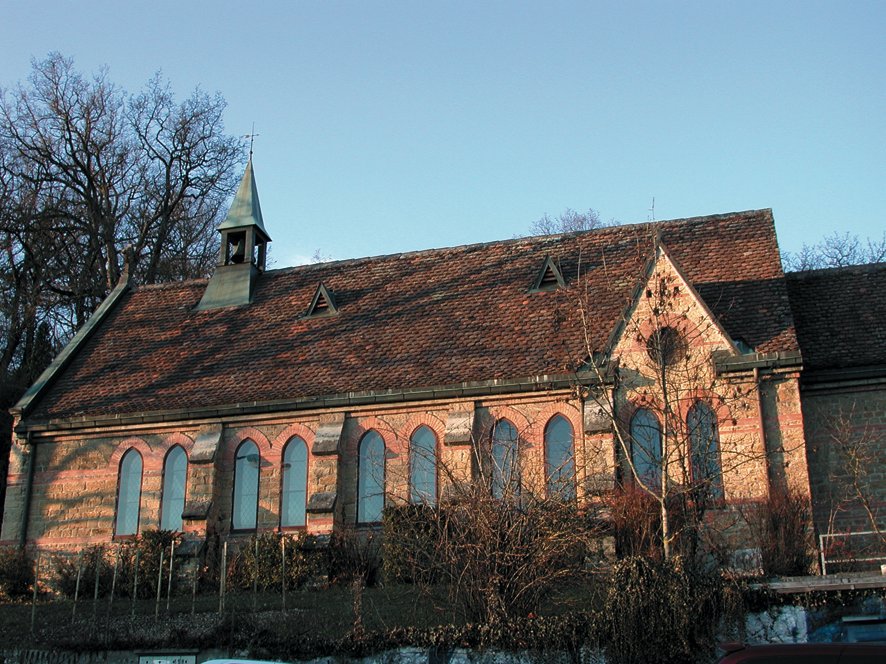 |
Chapel built in memory of La Trobe by his second wife, Rose de Meuron (née de Montmollin) in 1878. It also commemorates the memory of their daughter, Isabelle, who died in 1874, aged 16. Memorial plaque. The chapel is now a church within the Reformed Church of the Canton of Neuchâtel. | |
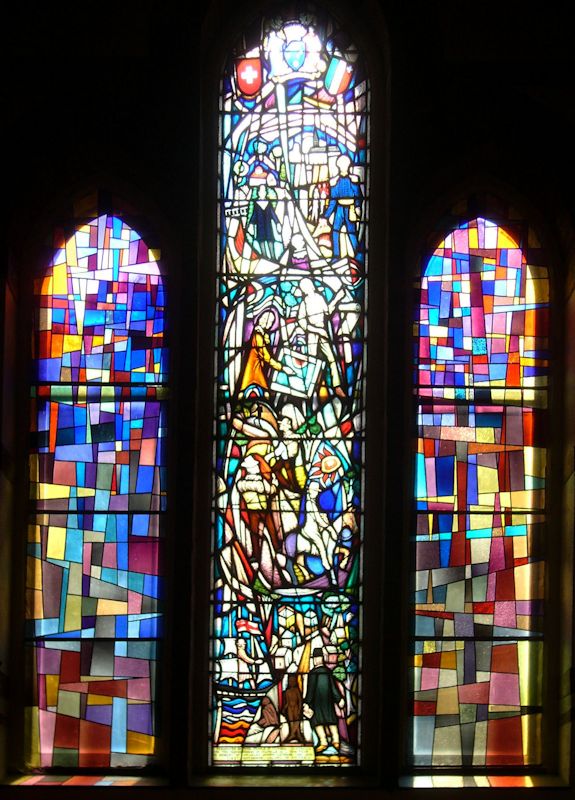 |
Stained glass window by Alan Sumner, 1978, commissioned by the Government of Victoria and installed in the central light of the west window of the chapel. La Trobe is depicted in each of the window’s four panels. | |||
| Site/Item | Location | Image | Description | |
| Other Items | back to top | |||
| Austin LatrobeMotor car | Victoria |  |
Australian Standard Sports car Austin Seven badged as an ‘Austin Latrobe’ by Latrobe Motors, of Latrobe (later La Trobe) Street, Melbourne, during the 1920s and 1930s. | |
| ‘Charles Joseph La Trobe’Medallion | Various, including: ◦ La Trobe University ◦ National Portrait Gallery, Canberra ◦ National Gallery of Victoria ◦ State Library Victoria ◦ St Peter’s Eastern Hill ◦ State Library of New South Wales ◦ Sydney Living Museums ◦ Newcastle City Gallery |
 |
Bronze low-relief portrait medallion of Charles Joseph La Trobe, by sculptor Thomas Woolner, 1853. There are 15 known versions in public collections or in private hands, worldwide. It is frequently on display at the State Library Victoria, Dome Level 5. | |
| ‘Charles Joseph La Trobe’Painting | Unknown |  |
Portrait of Charles Joseph La Trobe, c.1835, probably painted by Johann-Friedrich Dietler, who created portraits of Sophie La Trobe (née de Montmollin) and her family, and later the La Trobes’ eldest daughter Agnes. This oil painting hung in the London apartment of La Trobe’s grandson, Captain Charles La Trobe (d.1967), but has been missing since that time. | |
| Golden testimonialCup | Unknown |  |
Golden cup weighing 170 ounces (4.82kg) presented to La Trobe at a valedictory ball held on 28 December 1853, in Lonsdale Street, Melbourne, in a specially constructed grand ball room. (Goldsmiths: Bond and Tofield, Melbourne. 40.5cm high, cost 1,000 guineas, or £1,050.) Description | |
| ‘HMAS Latrobe’ J234Ship | New South Wales/Victoria | 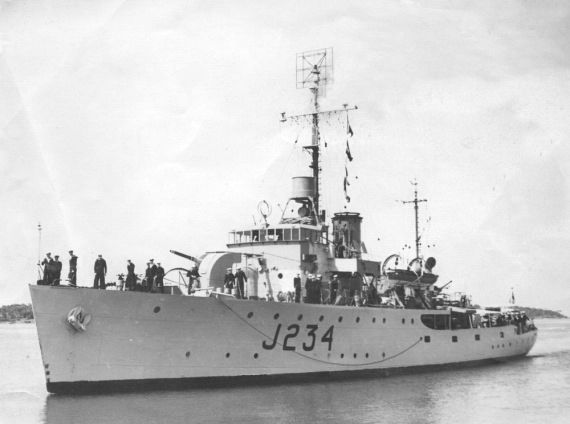 |
Minesweeper/corvette, built at Mort’s Dock & Engineering in Sydney in 1942 for the Royal Australian Navy and named after the town of Latrobe in Tasmania. She served off Darwin, New Guinea and Borneo until 1945 and then became a training ship at the Flinders Naval Depot until 1952. She was sold for scrap in 1956. | |
| ‘La Trobe’Horse | Victoria |  |
Race horse (black gelding, 1931), sire Simeon’s Fort. Raced in mid 1930s for 35 starts: Melbourne Cup 1934 (3rd of 22), Australian Cup 1935 (2nd of 15) and Sydney Cup 1935. A ‘smart stayer’, initially trained as a trooper’s horse at the Bundoora police depot. Owner G. L. Scott. | |
| La Trobe InnBuilding | Pakenham View Map |
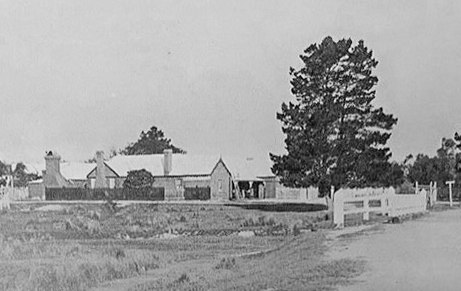 |
Hotel founded in 1847 on the Toomuc Creek, on the route to Gippsland. Became known as Bourke’s Hotel, after its early owners; currently Castello’s Pakenham Hotel (rebuilt). Early patrons included Bishop Charles Perry and Mrs Perry, and (it is thought) Bishop Goold and Dr Ferdinand von Mueller. | |
| S-303 C J La TrobeLocomotive | Victoria | 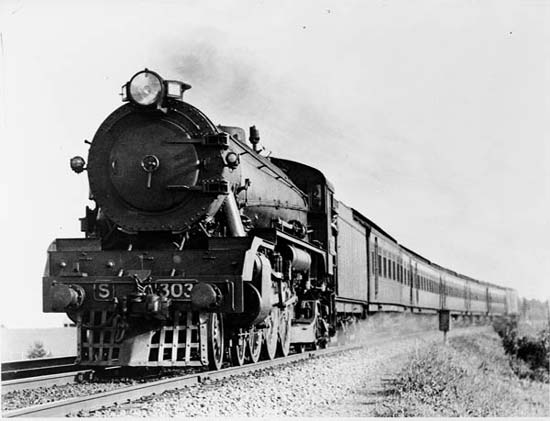 |
Steam locomotive built in 1930 at Newport Railway Workshops and converted to oil firing 1951. In service for the Spirit of Progress passenger train from Melbourne to Albury until May 1954, having completed 2.3 million kilometres. Scrapped, a streamlined view, brass plate. | |
| 3d. Charles La TrobePostage stamp | Australia |  |
Commemorative three-pence postage stamp issued on the centenary Victoria’s separation from New South Wales, self-government commencing 1 July 1851. Designer and engraver: Frank D. Manley. The first Legislative Council of Victoria was sworn in on 11 November 1851, while the first Parliament of Victoria (responsible government with two houses of Parliament) was sworn in on 23 November 1856. | |
| Villa La TrobeBuilding | South Road, Brighton | 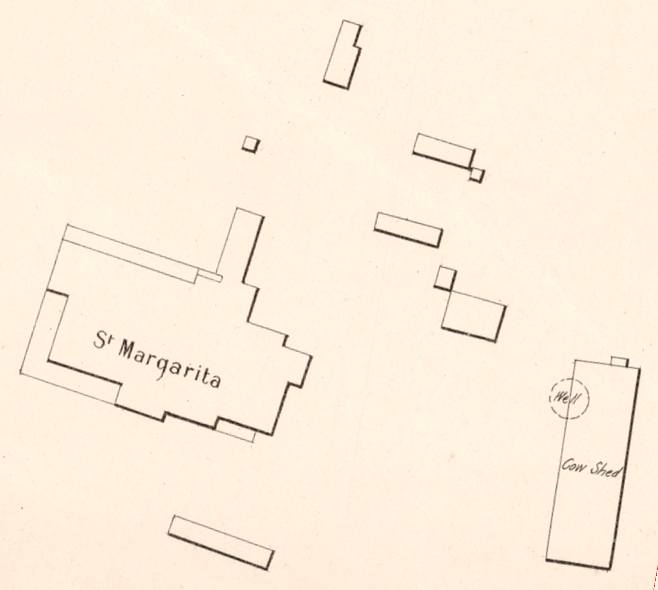 |
Large nineteenth-century timber rural residence of Sir Charles MacMahon, Speaker of the Parliament of Victoria, located on nearly 10 hectares, on the southern side of South Road, opposite Cavendish Place, Brighton. Renamed ‘Santa Margarita’. DEMOLISHED. | |
Compiled by Helen Armstrong, presentation by John Botham
Comments and pictures to info09@latrobesociety.org.au
